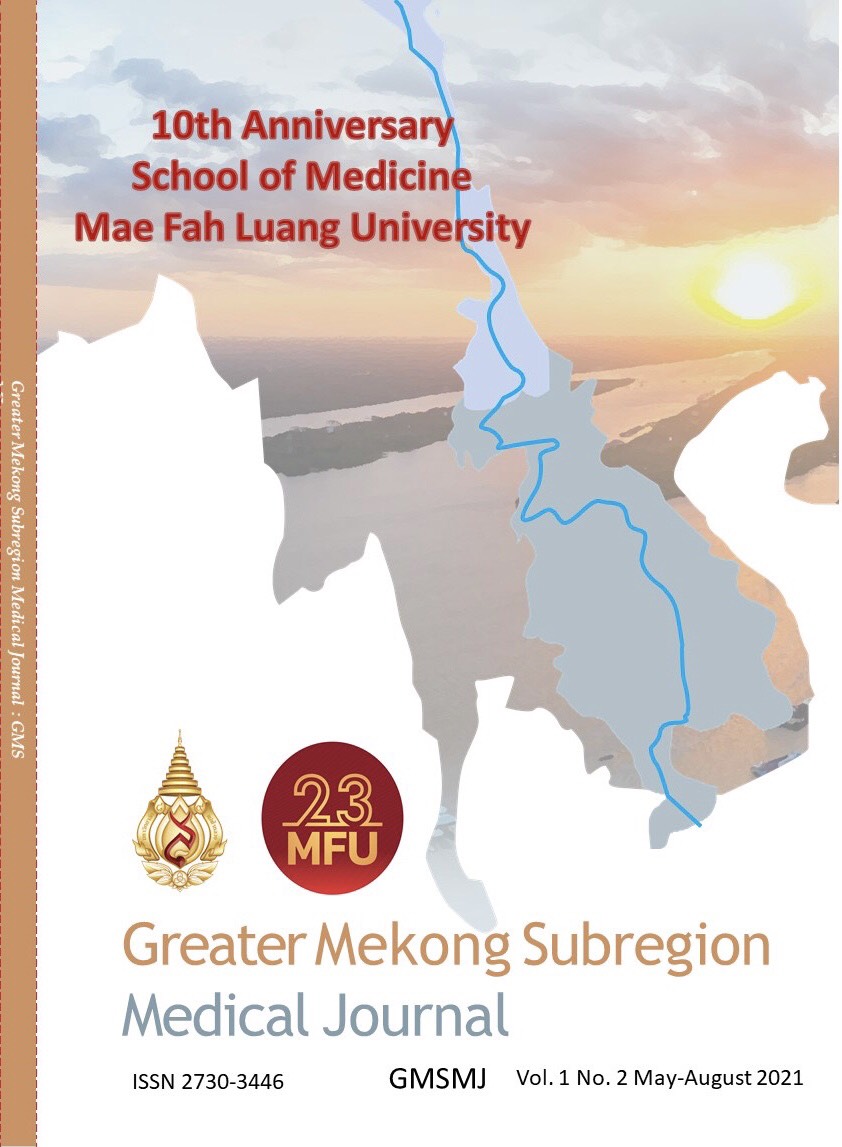Antibacterial Activity against Streptococcus mutans of Brass-Ash-Derived Zinc Oxide Nanoparticles
Keywords:
Zinc oxide, Streptococcus mutans, Antibacterial activityAbstract
Background: In recent years, popularity has been grown into management of industrial wastes or chemical by-products, and brass ash is the one to be in consideration. With its high amount of zinc oxide (ZnO), this fly ash is able to be processed for ZnO which provides a lot of useful medical applications, especially antimicrobial activity against certain kinds of bacteria.
Objective: This study aims to examine whether antibacterial activity against Streptococcus mutans (S. mutans) of waste-derived ZnO is obtained by which size of the milled particles.
Method: Once the ash was obtained, it was then purified for ZnO using chemical precipitation method. Subsequently, purified ZnO (S0) was milled in a high energy ball miller under a variety of milling durations: untreated, 0.5-hour milled (S0.5), and 1.0-hour milled (S1). Characterization of ZnO was done through x-ray fluorescence (XRF) analyzer for element composition, x-ray diffraction (XRD) machine for determination of crystallographic parameters, as well as scanning electron microscope (SEM) for particle size distribution. Purified and milled ZnO was, at last, tested for its antibacterial activity against S. mutans using microbroth dilution method compared to commercial ZnO (C), and the result was interpreted using a microplate reader.
Results: ZnO at 99% purification was synthesized in the process. Its size means were 123.99 nm for untreated ZnO, and 104.41 nm and 76.22 nm respectively after being milled. Of all the sizes compared, optimal antibacterial activity, eventually, was acquired from ZnO in size of 76.22 nm (milled for an hour), which its minimal inhibitory concentration (MIC) was 28.125 μg/ml.
Conclusion: The smaller the size of ZnO, the greater the antibacterial activity is. Aside from the main objective, chemical precipitation process could purify ZnO and size distribution was affected by milling time. For further study, the author suggests that synthesized ZnO should be incorporated into ZnO-containing dental products and be tested for its significant change in properties. Also, testing of brass-ash-derived ZnO on other bacteria is essential for further research.
References
Austral Wright Metals - Ferrous N. Metal Alloys - Properties and Applications of Brass and Brass Alloys [Internet]. AZoM.com. 2021 [cited 17 April 2021]. Available from: https://www.azom.com/article.aspx?ArticleID=4387.
Massacci P, Timur S, Gürmen S, et al. BENEFICIATION OF BRASS ASHES. Proceedings of the XXI INTERNATIONAL MINERAL PROCESSING CONGRESS [Internet]. 1st ed vol.13. Rome: Elsevier; 2000 [cited 18 April 2021]. Available from: https://www.elsevier.com/books/proceedings-of-the-xxi-international-mineral-processing-congress-july-23-27-2000-rome-italy/massacci/978-0-444-50283-4.
Myerson AS, Robinson P, Tabah S. METHOD FOR THE PURIFICATION OF ZINC OXIDE CONTROLLING PARTICLE SIZE. [Internet]. 1996 [cited 18 April 2021];:1, 10-26. Available from: https://patentimages. storage.googleapis.com/3a/2d/e8/fb073d0e09d03b/US6696029.pdf.
Laurin M, Paspek SC. PROCESS FOR PURIFYING ZINC OXIDE [Internet]. 2021 [cited 18 April 2021];: 1, 4-9. Available from: https://patentimages.storage.googleapis.com/74/f4/d5/4c1e2edd3be03c/US20130064743A1.pdf.
Aneesh PM, Vanaja KA, Jayaraj MK. Synthesis of ZnO nanoparticles by hydrothermal method. Nanophotonic Materials IV [Internet]. 2007 [cited 18 April 2021]; 6639:66390J-1- 66390J-8. Available from: https://www.spiedigitallibrary.org/conferenceproceedings-of-spie/6639/66390J/Synthesis-of-ZnO-nanoparticlesby-hydrothermal-method/10.1117/12.730364.short?SSO=1&tab=ArticleLink.
Agarwal H, Venkat Kumar S, Rajeshkumar S. A review on green synthesis of zinc oxide nanoparticles – An eco-friendly approach. ResourceEfficient Technologies [Internet]. 2017 [cited 18 April 2021];3(4): 406-413. Available from: https://www.researchgate.net/publication/316248463_A_review_on_green_synthesis_of_zinc_oxide_nanoparticles_-_An_ecofriendly_approach.
Scientific Committee on Consumer Safety. GUIDANCE ON THE SAFETY ASSESSMENT OF NANOMATERIALS IN COSMETICS [Internet]. 2012 [cited 18 April 2021]. Available from: https://ec.europa.eu/health/scientific_committees/consumersafety/docs/sccs_s_005.p
Zhang Y, Nayak T, Hong H, et al. Biomedical Applications of Zinc oxide nanomaterials. Current Molecular Medicine 2013: 13 (10): 1633-45.
Dimapilis EA., Hsu C., Mendoza RM, et al. Zinc oxide nanoparticles for water disinfection. Sustainable Environment Research 2018; 28 (2): 47-56.
Oprea O, Andronescu E, Ficai D, et al. ZnO Applications and Challenges. Current Organic Chemistry 2014; 18 (2): 192-203.
Andrade V, Martínez A, Rojas N, et al. Antibacterial activity against Streptococcus mutans and diametrical tensile strength of an interim cement modified with zinc oxide nanoparticles and terpenes: An in vitro study. The Journal of Prosthetic Dentistry. 2018; 119 (5): 862.e1-862.e7.
Gulabivala K, Ng Y. Non-surgical root-canal treatment. Endodontics [Internet]. 2014 [cited 18 April 2021]. Available from: https://www.researchgate.net/publication/285433473_Nonsurgical_root-canal_treatment.
Chogle SM, Kinaia BM, Goodis HE. Scope of nanotechnology in endodontics Nanobiomaterials in Clinical Dentistry [Internet]. 2nd ed. 2019 [cited 18 April 2021]. Available from: https://www.sciencedirect.com/science/article/pii/B9780128158869000218#:~:text=Irrigants%2C%20medicaments%2C%20sealers%2C%20and,scaffolds%20and%20growth% 2Dfactor%20delivery.
Hurlbutt M. CAMBRA: Best Practices in Dental Caries Management. [Internet]. 2011 [cited 18 April 2021]; 96-108. Available from: https://rivastar.com/wpcontent/uploads/Hurlbutt-2011-CAMBRA-Best-Practice-in-DentalCaries-Management-1.pdf.
Forssten SD, Björklund M, Ouwehand AC. Streptococcus mutans, Caries and Simulation Models. Nutrients 2010; 2 (3): 290–298.
Cockerill F. Methods for dilution antimicrobial susceptibility tests for bacteria that grow aerobically. 9th ed. Wayne, Pa.: Clinical and Laboratory Standards Institute; 2012.
Wikler M. Performance standards for antimicrobial susceptibility testing. 26th ed. Wayne, Pa.: Clinical and Laboratory Standards Institute; 2016. 18. High Energy Ball Mill E max [Internet]. Haan: Restch [cited 18 April 2021]. Available from: https://www.retsch.com/dltmp/www/57d93951-84f4-40a9-8e68-2540bc282b86-899d5106bca8/brochure_emax_en.pdf.
Ball Mills - Guidelines for sample amount and ball charge [Internet]. Haan: Restch; 2019 [cited 18 April 2021]. Available from: https:// pimresources.coleparmer.com/literature/04182-09-ball-and-jar-guideen.pdf.
Yadav S. Synthesis and Characterization of Copper Nanoparticles, Using Combination of Two Different Sizes of Balls in Wet Ball Milling. International journal of Emerging Trends in Science and Technology. 2016.
Hanke T. Ultrafine Grinding with Laboratory Ball Mills [Internet]. Haan: Restch; 2015 [cited 18 April 2021]. Available from: https://www.researchgate.net/publication/308417026_Ultrafine_Grinding_with_Laboratory_Ball_Mills.
Hegela C., Jonesb C., Cabreraa FJ, Yáñezb MJ., Bucalaa V. Particle size characterization: Comparison of laser diffraction (LD) and scanning microscopy (SEM). Acta Microscopica 2014; 23 (1): 11–17.
Observation of thermochromism in Zinc Oxide by UV-Visible Diffuse Reflectance Spectroscopy [Internet]. New York: HARRICK SCIENTIFIC PRODUCTS; [cited 18 April 2021]. Available from: https://www.harricksci.com/sites/default/files/pdf/application_notes/HVC_%20App-notes_Observation_of_hermochromism_in_ZnO.pdf






